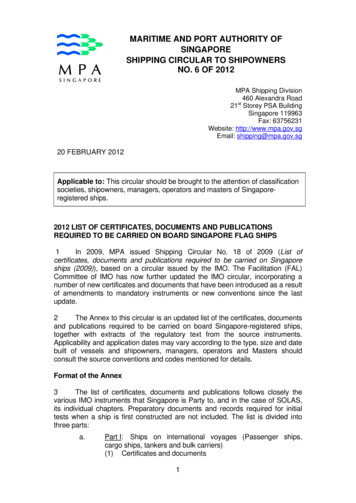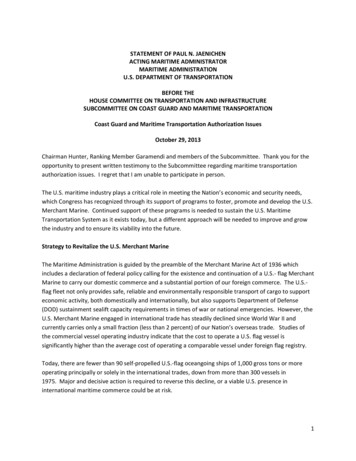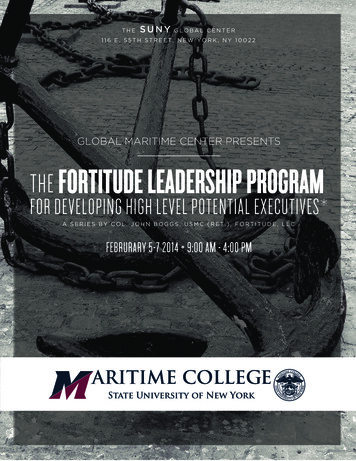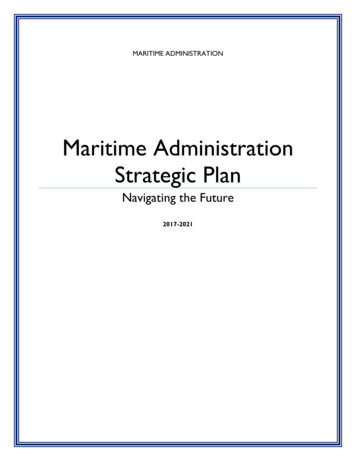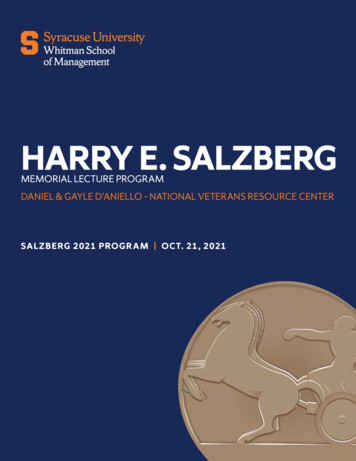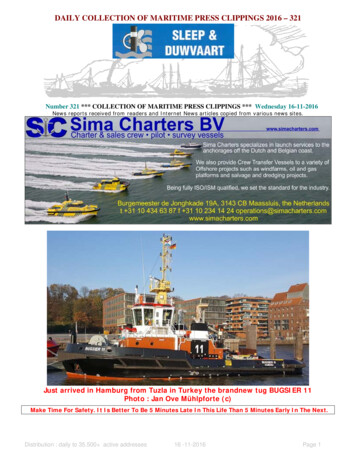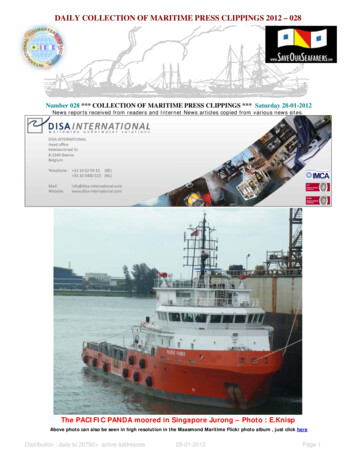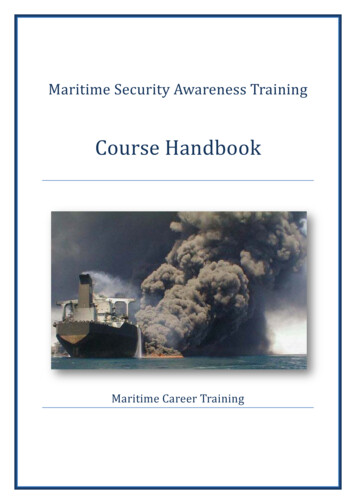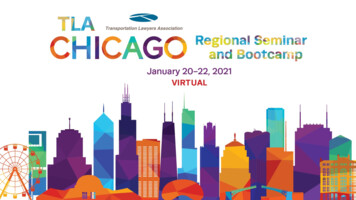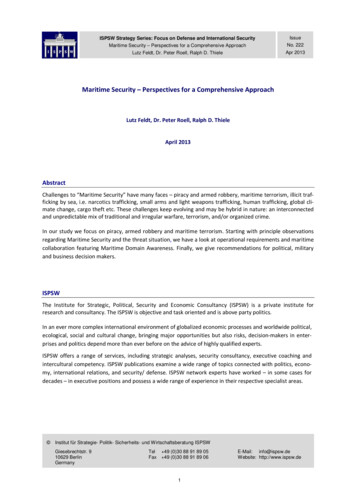
Transcription
DAILY COLLECTION OF MARITIME PRESS CLIPPINGS 2017 – 262Number 262 *** COLLECTION OF MARITIME PRESS CLIPPINGS *** Monday 18-09-2017News reports received from readers and Internet News articles copied from various news sites.The brandnew Damen Shipyards group built BIBBY WAVEMASTER I at DP near the L4-Bplatform in the Dutch coastal watersPhoto : Flying Focus Aerial Photography www.flyingfocus.nl Make Time For Safety. It Is Better To Be 5 Minutes Late In This Life Than Many Years Early In The Next.Distribution : daily to 37.500 active addresses18-09-2017Page 1
DAILY COLLECTION OF MARITIME PRESS CLIPPINGS 2017 – 262Your feedback is important to me so please drop me an email if you have any photos orarticles that may be of interest to the maritime interested people at sea and ashorePLEASE SEND ALL PHOTOS / ARTICLES TO :newsclippings@gmail.comIf you don't like to receive this bulletin anymore :To unsubscribe click here (English version) or visit the subscription page on our en.aspx?lan en-USEVENTS, INCIDENTS & OPERATIONSFor those needing assistance in Mongla, Bangladesh, the contact number is on the gunwale.Photo : Paul Martin @ Britannia Maritime Consultants (c)THE Alliance Creates Fund to Stop Second HanjinDisasterThe US government has voted for safeguards against another Hanjin disaster by granting approval for a US 50 millioncontingency fund in case a member of the Japanese-led shipping group THE Alliance becomes financially troubled. Under thenew agreement, the member carriers of THE Alliance, Hapag-Lloyd, K Line, MOL, NYK, and Yang Ming, will help a participatingline recover from insolvency or financial distress should the situation occur. Each line shares vessels and charters andexchanges space on each other’s ships, however, the bankruptcy of container shipping line Hanjin – once the seventh largestcarrier in the world, has served as a wake-up call to many in the maritime industry after it left more than US 14 Billion worth ofcargo stranded at sea on 100 ships scattered around the globe. Each carrier is initially contributing US 1 million to thecontingency trust fund and a further 9 million in additional funds or through a letter of credit. In a statement, Daniel B. Maffei,a Commissioner with the Federal Maritime Commission (FMC) that voted for the fund and serves to regulate the US’sinternational ocean transportation, said: "In the bankruptcy’s aftermath, one of the biggest challenges facing individual oceanDistribution : daily to 37.500 active addresses18-09-2017Page 2
DAILY COLLECTION OF MARITIME PRESS CLIPPINGS 2017 – 262carriers and ocean carrier alliances is how best to prepare and mitigate the impact of a future insolvency event should oneoccur. "THE Alliance members have addressed that challenge by filing the amendment to THE Alliance Agreement that theCommission has unanimously voted to approve September 14, 2017 “With this amendment, THE Alliance members haveestablished a clear procedure that will apply should one of their members become financially distressed or insolvent. “Theyhave established a contingency fund that will be available to ensure the continued movement of boxes should such an eventoccur. “While more steps and resources might be needed to effectively limit the collateral damage from another bankruptcy,THE Alliance should be commended for independently choosing to take this significant pro-active step.” Read about how portsand terminals were facing unprecedented challenges in Drewry's 'Mega-Alliance Impact' technical paper written by NeilDavidson, Senior Analyst - Ports & Terminals, Drewry Maritime Research. FMC Commissioner William P. Doyle explained in anannouncement that it was his belief that if a carrier joins an alliance, “it is the responsibility of the alliance members to ensurethe cargo gets to where it needs to go”. Hanjin was once part of the CKYHE Alliance, which consisted of Cosco Container Lines,K Line, Yang Ming Line, Hanjin Shipping, and Evergreen Line before the bankruptcy of its largest member forced it todisband.Doyle said: “If a carrier fails and that carrier is party to an alliance, the cargo carried on the failed company’s ships mayequate to a fraction of the container volume carried. “Many containers may belong to the other carriers in the alliance. My pointis this — Hanjin was carrying the cargo not only of Hanjin but of the other alliance members of CKYHE as well. “Everyonesuffered in the ocean maritime transportation chain. So it is essential that all take responsibility. The responsibility is to get theship into port and get it unloaded, get the empties onboard and get the ship back out to sea.” Source : porttechnologyThe HERMOD loaded onboard the DOCKWISE VANGUARD in Rotterdam Alexia harbour Photo : Hugo Sluimer CLICK at the photo & Hyperlinks in text !Hurricane Irma – issues arising under contracts ofcarriageThe disruption to cargo vessels recently caused by Hurricane Irma has raised a number of legal issues. The following isintended as general guidance to members on some of the issues commonly encountered. Given the number of charterpartiesand bills of lading that are governed by English law, the guidance is given from an English law perspective.Deviations from routeWhere cargo-carrying vessels have deviated from their planned route to avoid and/or shelter from hurricane conditions, this willgive rise to the late delivery of cargo and to potential losses to cargo receivers. Cargo receivers who have incurred such losses,however, will not be entitled to recover where their cargo has been carried under bills of lading that incorporate the Hague orHague Visby Rules, both of which state in Article IV Rule 4:‘Any deviation in saving or attempting to save life or property at sea or any reasonable deviation shall not be deemed to be aninfringement or breach olof this convention or of the contract of carriage, and the carrier shall not be liable for any loss ordamage resulting therefrom’. The above provision may also protect the owners of vessels from claims from their charterers forlosses arising from deviation where, as often happens, the Hague or Hague Visby Rules have been incorporated into the charterterms.Distribution : daily to 37.500 active addresses18-09-2017Page 3
DAILY COLLECTION OF MARITIME PRESS CLIPPINGS 2017 – 262Bills of lading – changing the place of dischargeIf it is not possible for cargo to be discharged at the place of discharge named in a bill of lading, the terms of the bill of ladingmay entitle the carrier to discharge the cargo elsewhere. If the terms of the bill of lading do not entitle the carrier to dischargeelsewhere, it may nonetheless be possible for the carrier to agree with the holder of the bill of lading that the cargo is to bedischarged at a substitute place of discharge. If such an agreement is entered into, the carrier will need to engage with its P&Iclub to ensure that the carrier has P&I cover for carriage to the substitute place of discharge. Also, if such an agreement isentered into, all bills of lading naming the original place of discharge will need to be surrendered by the bill of lading holder anddestroyed. If they are not, the carrier will run the risk of an original bill of lading being used to sell the cargo, the carrier beingliable to the buyer for non-delivery of the cargo at original place of discharge, and the carrier not being insured for that liabilityunder the terms of the carrier’s P&I cover.Voyage charters – named load and discharge portsWhere the terms of a voyage charter name a port and/or berth at which cargo is to be loaded, or at which cargo is to bedischarged, and it is not possible for cargo to be loaded (or discharged) at that place, further terms in the charter may give aright to the owners of the vessel to load or discharge cargo at a substitute place.For example the very commonly used Gencon 1994 voyage charter form states at Clause 1:‘The said vessel shall proceed to the loading port or place stated in Box 10 or so near thereto as she can safely get and liealways afloat, and there load a full and complete cargo and being so loaded the vessel shall proceed to the discharging portor place stated in Box 11 or so near thereto as she may safely get and lie always afloat ’Such clauses should, however, be viewed cautiously and legal advice taken before they are acted upon. The best practicalapproach, where loading or discharge of cargo at a contractually specified place is not possible, is likely to be an agreementbetween the owner and charterer of the vessel as to where and how cargo is to be loaded (or discharged as the case may be).Frustration of contractsIf it is not possible to load or discharge cargo at an agreed place of loading or discharge specified in a contract of carriage (eg abill of lading or a charterparty) and there is no term in the contract permitting a substitute place to be used, the contract maybe viewed as frustrated. If a contract is frustrated, the parties will no longer be obliged to perform it, and neither party will beable to recover from the other for any losses arising from non-performance.However, identifying whether or not a contract of carriage is frustrated as a result of prevailing circumstances, can be a verydifficult exercise. It may depend upon how long the circumstances have prevailed, how long they are likely to prevail, whetherthe cargo being carried is perishable, and various other factors.Force majeureUnder English law there is no general concept of force majeure, or general right to declare force majeure as a way of avoidingor limiting contractual obligations. However, where terms in a charterparty or bill of lading specify what is to be consideredforce majeure (including perhaps various weather conditions), and set out what rights and obligations the parties are to have ifforce majeure occurs, those terms will be effective.Time charters – unsafe ports and berthsTime charterers of vessels are under an implied obligation to order the vessel only to ports and berths that are safe, and not toports and berths that are unsafe. A port or berth is unsafe for a vessel if, in the course of reaching or using or returning from it,the vessel is exposed to dangers which good seamanship cannot avoid. If a vessel is damaged at a port or berth due to anabnormal occurrence, however, this will not place the time charterer in breach of its implied obligation. However, what dangerscan be avoided by good seamanship, and what will constitute an abnormal occurrence in any given circumstances, may beopen to debate. Where the time charterer of a vessel has ordered the vessel to a port or berth that is unsafe, there is anobligation upon the time charterer to name a substitute port that is safe.If the time charterer refuses to order the vessel to a substitute place of discharge that is safe, the owner of the vessel maytreat the charter as repudiated and claim damages from the charterer for any losses that the owner has suffered. Again,however, the owner of the vessel should approach the situation cautiously. The wrongful repudiation of charters can causehuge losses, recoverable in damages from the party that has wrongfully repudiated the charter.Time charters – payment of hireUnder time charters, hire continues to be payable for a vessel unless circumstances have arisen which bring the vessel ‘off hire’as defined in the charterparty terms. Whether or not delays caused to vessels by Hurricane Irma will have brought timechartered vessels off hire will therefore depend upon the charter terms agreed for each vessel, which may need to bescrutinised closely by the owners and charterers concerned.Cargo damage\Distribution : daily to 37.500 active addresses18-09-2017Page 4
DAILY COLLECTION OF MARITIME PRESS CLIPPINGS 2017 – 262If cargo-carrying vessels have been unable to avoid the effects of Hurricane Irma, with the result that cargo on board hasbecome damaged, the carriers of the cargo may have a defence to claims for that cargo damage under Article IV Rule 2 of theHague and Hague Visby Rules which states: “Neither the carrier nor the ship shall be responsible for loss or damage arising orresulting from: (c) Perils, dangers, and accidents of the sea and other navigable waters.”The above defence will only be available, however, to carriers who have exercised due diligence to make their vessel seaworthybefore and at the beginning of the voyage (as required by Article III Rule 1 of the Hague and Hague Visby Rules).Further guidanceThe above notes are intended only for the general guidance of members. If members have disputes connected with damage ordelays caused by Hurricane Irma they are advised to take legal advice, not least because the wording of contracts of carriage(bills of lading, charterparties and other contractual arrangements) will vary widely. Source: The Standard ClubThe HERMOD riding crew for her voyage to the DOCKWISE VANGUARD with towmaster, Rotterdam pilots, KRVE boatmenand Heerema and Dockwise representatives Photo : Hans Hoffmann www.zeesleperelbe.nl (c) CLICK at thehyperlinks !Asia Fuel Oil-Market gets boost as Singapore stocks fallAsia’s physical and paper fuel oil markets were boosted on Thursday as official weekly data showed Singapore fuel oilinventories fell 11 percent, ending the five-week run of inventory builds. The decline in inventories helped improve the marketoutlook, widening near-dated time spreads, arbitrage spreads and cracks in the paper market, as well as boosting cashpremiums for spot fuel oil cargoes, industry sources said. Singapore onshore fuel oil inventories fell 11 percent, or 449,000tonnes, to a total of 3.5 million tonnes in the week to Sept. 13, official data showed Weekly net imports into Singapore fell 20 percent to a five-week low of 575,000 tonnes. Compared with the same time last year Singapore’s fuel oil stocks are now 9 percent higher.On Wednesday fuel oil inventories in the Fujairah oil hub slipped 0.7 percent in the week to Sept. 11 to a total of about 1.59million tonnes.Three 180-cst fuel oil cargo trades were reported in the Platts window totalling 60,000 tonnes as well as one 40,000 tonne 380cst cargo. Mercuria bought all three 180-cst cargoes, two from Gunvor and one from Vitol. Mercuria in September has bought200,000 tonnes of fuel oil in the window, all of which are 180-cst fuel oil cargoe Trafigura sold Thursday’s fourth 380-cst cargoDistribution : daily to 37.500 active addresses18-09-2017Page 5
DAILY COLLECTION OF MARITIME PRESS CLIPPINGS 2017 – 262to BP. This comes after Trafigura in September bought a total of 1.031 million tonnes of 380-cst fuel oil in the window. Kuwait’sKPC sold up to 80,000 tonnes of straight-run fuel oil to Saudi’s ATC for loading on Sept. 13-14 at an unknown price level,industry sources said.One tanker report showed ATC fixed the United Journey aframax vessel to load 80,000 tonnes of fuel oilfrom Min al-Ahmadi on Sept. 13-14 with no specific destination. KPC issued the invitation to tender for the cargo on Sept. 7,with the tendering closing on the following day. Prior to the decommissioning of its 200,000 barrels per day (bpd) Shuaibahrefinery on April 1, KPC typically exported 380-cst high-sulphur fuel (HSFO), rarely SRFO cargoes – Saudi’s Samref refineryoffered up to 80,000 tonnes of HSFO for loading on Sept. 29 to Oct. 1 from Yanbu in an offer that has already closed tobidders.Chinese refineries processed 6.5 percent more crude oil in August than a year earlier at 47.12 million tonnes, or about11.1 million barrels per day, data from the National Bureau of Statistics showed on Thursday. Source: Reuters (Reportingby Roslan Khasawneh; Editing by Greg Mahlich)Box volumes at Port of Singapore jump 10pc inAugust to 2.95 million TEURegional Container Line’s YANTRA BHUM approaching the TJ Pagar container Terminal – Photo : Aidan Brown (c)THE Port of Singapore handled 2.95 million TEU in August, representing an increase of 10.1 per cent compared to the samemonth last year, according to data from the Maritime and Port Authority of Singapore (MPA). In the first eight months of 2017,Singapore's throughput rose 7.5 per cent year on year to total 21.97 million TEU, reported Seatrade Maritime News ofColchester, Essex.On a month-on-month basis, August's volumes were up 2.4 per cent compared to July's throughput of 2.88million TEU. Source : SchednetLA has record August, up 6.1pc to 847,857 TEU, LBup 8pc to 692,375 TEUSAN PEDRO BAY ports of Los Angeles and Long Beach posted excellent August cargo results with LA leading with a recordbreaking 6.1 per cent year-on-year increase to 847,857 TEU while LB had an eight per cent gain to 692,375 TEU."We plan toDistribution : daily to 37.500 active addresses18-09-2017Page 6
DAILY COLLECTION OF MARITIME PRESS CLIPPINGS 2017 – 262build on this momentum by focusing on innovative ways to improve efficiencies, including a first-of-its kind information portalsystem with GE Transportation that will be introduced at all of our container terminals in the coming months," said LA Portexecutive director Gene Seroka. August LA laden boxes increased 5.1 per cent to 432,479 TEU. Laden exports rose four percent to 159,197 TEU. Empties were up 9.2 per cent. The port's busiest month was November 2016 with its 877,564 TEUthroughput. Long Beach imports in August surged 10.6 per cent year on year to 355,715 TEU making it the third-highestmonthly import total in the port's 106-year history. But Long Beach exports were down 26.3 per cent to 117,290 TEU due toshifts in vessel alliances, according to the port. Empties increased 37 per cent to 219,370 TEU. Through the first eight monthsof 2017, total Long Beach cargo volumes were up 6.6 per cent from the same 2016 period, according to port statistics. SaidLong Beach port director Mario Cordero: "The modest economic growth we've seen since the Great Recession has beenreplaced this year by robust gains, at least when measured by goods coming into the United States. Source : SchednetNSRI tow the passenger ferry to Robben IslandPhoto left : The casualty ferry being towed by the NSRI Table Bay sea rescue craft SPIRIT OF VODACOM into Murray's Bayharbour, and escortedbytheNSRIHeadquarterssearescue craft SPIRIT OFROUND TABLE andthe NSRI Hout Bay searescue craft ALBIEMATTWESQuentinBotha, NSRI Table Baystationcommander,said:Followingthesuccessful rescue ofpassengers from theRobben Island passenger ferry THANDI and once all of the casualty crew and passengers were safely taken to the Port ofTable Bay the NSRI Table Bay sea rescue craft SPIRIT OF VODACOM went back out to sea to join the NSRI Headquarters searescue craft SPIRIT OF ROUND TABLE and the NSRI Hout Bay sea rescue craft ALBIE MATTHEWS (on the scene at thelisting casualty ferry) and a towline was rigged from the sea rescue craft Spirit of Vodacom onto the casualty ferry and thecasualty ferry was towed to Murray's Bay harbour at Robben Island. Once safely berthed water extrication pumps were used byNSRI crew and the casualty ferry was pumped free of water and re-floated and secured to a berthing where she remainsberthed at Murray's Bay harbour, Robben Island. source : www.searescue.org.za Sea Rescue is the charity that saves liveson South African waters. NSRI is manned by 1000 volunteers at 31 bases around the coast and on 5 inland dams.Donations, bequests and sponsorships cover the annual running cost of R84m. The volunteers save us a salarybill in excess of R350m per annum.New global shipping convention takes off, maygulp 100bThe shipping industry may collectively need to spend around 100billion in order to install the new ballast water treatmentsystems required by law, in order to become compliant with the Ballast Water Management (BWM) Convention, which becameeffective. The convention initiated by the International Maritime Organisation (IMO), requires that ships will manage theirballast water to remove, render harmless, or avoid the uptake or discharge of aquatic organisms and pathogens within ballastwater and sediments. The new treaty marks a landmark step towards halting the spread of invasive aquatic species, which cancause havoc for local ecosystem, affect biodiversity, and lead to substantial economic losses. The treaty had earlier beenestimated to unlock an unprecedented private sector investment of about 30billion over the next few years. However, a recentreport by the International Chamber of Shipping (ICS), said the industry would need to invest about 100billion to meet therequirement of the treaty. Worried about the development, Chairman, ICS, Esben Poulsson, called on ship-owners, equipmentmanufacturers and governments to cooperate to ensure that proper implementation of this significant new regulatory regimewill deliver maximum environment benefit. “We need to ensure, so far as practicable, that the systems installed on ships willindeed be fit for purpose in all known operating conditions worldwide. We are therefore advising shipping companies that theyshould make it clear to equipment manufacturers they will only consider fitting treatment systems, which have been certified inaccordance with the revised IMO type-approval standards adopted in 2016, even though this is not yet a mandatoryrequirement.” The IMO had in July, adjusted the implementation dates of the Convention so that existing ships (shipsconstructed before September 8) will not be required to install treatment systems until their first International Oil PollutionDistribution : daily to 37.500 active addresses18-09-2017Page 7
DAILY COLLECTION OF MARITIME PRESS CLIPPINGS 2017 – 262Prevention (IOPP) renewal survey after September 8, 2019. “We acknowledge the pragmatic approach to implementationtaken by IMO member states, who accepted the arguments made by ICS and other industry associations that there is littlelogic, from an environmental protection standpoint, in requiring thousands of ships to comply until they can be fitted withsystems that have been approved under the more stringent standards,” Poulsson explained. “Ship-owners must make full useof this additional time to identify and invest in far more robust technology to the benefit of the environment.” “And in view ofthe significant concessions that IMO has now made in response to the industry’s representations, shipping companies shouldnot anticipate any further relaxation to the implementation schedule,” he added ICS added that it believes that as a result ofthe industry’s intensive efforts to explain its implementation challenges to regulators, shipowners will hopefully now have theclarity needed to get on with the job. Also commenting, the Secretary-General, IMO, Kitack Lim, said: “The entry into force ofthe Ballast Water Management Convention will not only minimise the risk of invasion by alien species via ballast water, it willalso provide a global level playing field for international shipping, providing clear and robust standards for management ofballast water on ships.” Source: The GuardianDe Elbe zoekt bemanning!Met 70 vrijwilligers onder wie 50 in varendedienst heeft de zeesleper Elbe een gezondeploeg vrijwilligers. Toch zijn we altijd op zoeknaar mensen die de handen uit de mouwenwillen steken en een aantal dagen per jaarbeschikbaar zijn om mee te varen alsbemanningslid. Voorwaarde voor aanmonsterenis een monsterboekje en een geldige medischekeuring. Voor stuurlieden en machinisten geldtdat zij in het bezit moeten zijn van een geldigevaarbevoegdheid. Met name onze brug enmachinekamerkunnenwataanvullinggebruiken. U vaart dan eerst een aantaleendaagse vaartochten mee ‘boven de sterkte’om het schip te leren kennen om daarnazelfstandig aan de slag te kunnen. Heeft u eenhart voor ons varend erfgoed en bent umeerdere weekenden per jaar beschikbaar als vrijwillig bemanningslid, stuur dan een bericht naar info@smcr.nlAssam Congress objects to dredging BrahmaputraBy Bikash Singh,GUWAHATI: The Congress in Assam has opposed to the BJP's ambitious project of dredging river Brahmaputra stating it is nota feasible project. Citing the report of the expert committee on fluvial morphology of Brahmaputra, sediment management witha possibility of dredging by adopting modern technology set up by the Assam government, Congress stated that dredging theentire length of the Brahmaputra 'will not be a feasible option for mitigating the flood and erosion hazards' caused by themighty river. Assam Pradesh Congress Committee (APCC) president Ripun Bora said, "Carrying out dredging activity will bewaste of public money. This will not moderate flood situations. Even the committee appointed by the state government hasopined against the dredging.The Assam government has rushed to procure dredgers without conducting a thorough study.""The committee has observed that massive dredging in the Indian part of the Brahmaputra may change the water quality of theriver and may impact the river's aquatic ecology," Bora added. The Assam government has asked a team of engineers to visitDistribution : daily to 37.500 active addresses18-09-2017Page 8
DAILY COLLECTION OF MARITIME PRESS CLIPPINGS 2017 – 262neighbouring Bangladesh to get a knowhow of the dredging process. Assam Chief Minister Sarbananda Sonowal directed thedepartment to depute a team of mechanical engineers for training at Bangladesh to enhance their knowledge. Sonowal askedofficials to carry out a survey on the highest water level of both the rivers during monsoon and their water bearing capacity.The proposed dredging of the 600-km stretch of the Brahmaputra from Sadiya to Dhubri is likely to start soon. The Centre hassanctioned Rs 400 crore for this project.The Dredging Corporation of India will do the dredging and the silt recovered will beused for highway construction. Source: indiatimesThe MONARCH arriving at the cruisetermnal in IJmuiden assisted by the port Towage Amsterdam operated tugSATURNUS Photo : Marcel Coster (c)Great Lakes Dredging wins 47 million Charlestondeepening, as biggest ship arrivesBy : Kirk MooreOn the same day Charleston, S.C., was visited by the biggest containership to ever enter its harbor, the Corps of Engineersannounced a 47 million dredging contract to make those port calls routine. A week after its debut at the Port of New York andNew Jersey, the 1,200’x152’ CMA CGM THEODORE ROOSEVELT passed under the Arthur Ravenel Jr. Bridge and tied up atthe Wando Welch Terminal. With a 14,414 TEU container capacity, the Roosevelt is the largest containership yet to have calledon East Coast ports – and the first of six in class to be built for Marseilles, France-based CMA CGM. To accommodate thoseships without tide delays, the Corps of Engineers will deepen the Charleston entrance channel from 45′ to a minimum 54’depth. Great Lakes Dredge and Dock Company LLC, Oak Brook, Ill., will dredge 6 million cubic yards of material using hopperdredges, a designated offshore disposal site, and complete the work by spring 2020, Corps officials said Thursday.Channeldredging and high bridges, like the Ravenel span and the newly elevated Bayonne Bridge straddling the approach to NewJersey container ports, are all infrastructure projects planned years in advance, anticipating the summer 2016 opening of widerlocks on the Panama Canal. For the workboat sector, the movement toward ever-larger carriers is bringing in bigger, morepowerful tugboats, faster boats for pilots, and training and simulator classes for masters and crew. “Our harbor will ultimatelybe the deepest on the East Coast, allowing vessels like the Roosevelt to transit without tidal restriction,” said Jim Newsome,president and CEO of the South Carolina Ports Authority, in a statement marking the ship’s arrival. “Today reaffirms our effortsand investments in terminals and infrastructure to prepare for the big ships being deployed to the East Coast following thePanama Canal expansion and completion of the new Bayonne Bridge.”Dubbed the Charleston Harbor Post 45 DeepeningProject, the deepening will require a second contract to be awarded later this year, Corps officials said. And it will take time forfull completion – an estimated 40 to 76 months, depending on funding, equipment availability, and environmental issues.Dredging is restricted to a December-to-March window each year to account for threatened and endangered species and fishspawning. A timeline still has to be finalized for dredging the upper and lower harbors and the Corps is looking to do thoseDistribution : daily to 37.500 active addresses18-09-2017Page 9
DAILY COLLECTION OF MARITIME PRESS CLIPPINGS 2017 – 262within the timeframe of the entrance channel work. The Roosevelt and her coming sister ships will be part of the weekly OCEANAlliance South Atlantic Express (SAX) service connecting Charleston, New York and other U.S. East Coast ports with Hong Kong,Yantian, Ningbo and Shanghai via the Panama Canal. The canal’s effect on trading patterns are showing clearly in Charleston,where 18 of its 24 weekly containership services are vessels that could not have transited the Panama Canal prior to itsexpansion, SCPA officials said. Source: WorkboatTop DP World, Hong Kong Officials DiscussStrategic PartnershipsDubai-based global marine terminal operator DP World and Hong Kong leaders recently discussed collaboration in a range ofsectors from ports, logistics and customs to education and innovation at a meeting held in Hong Kong this week DP WorldGroup chairman and CEO Sultan Ahmed Bin Sulayem met with Hong Kong’s chief executive Carrie Lam at Government House inthe presence of the Consul General of the UAE to Hong Kong, Nabila Abdelaziz Nasir Saeed Alshamsi, Hong Kong secretary fortransport and housing, Frank Chan Fan, Hong chief executive-elect office director, Kong Eric Chan Kwok-ki, and senior companyofficials, said a statement. The development of financial services and cruise terminal facilities, customs collaboration
DAILY COLLECTION OF MARITIME PRESS CLIPPINGS 2017 - 262 . Distribution : daily to 37.500 active addresses 18- 09-2017 Page 3 carriers and ocean carrier alliances is how best to prepare and mitigate the impact of a future insolvency event should one occur.
